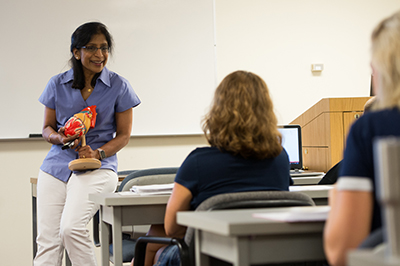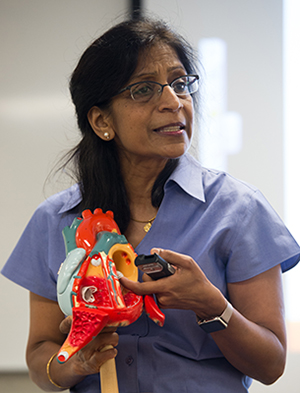 When a person imagines a classroom, a more traditional visual may come to mind—students arranged in rows, quickly jotting down notes off slides that accompany a lecture. That standard method of teaching and learning has proved useful in academia. But, perhaps, a flipped perspective, a creatively reversed approach, would prove more successful for the generation and retention of new knowledge.
When a person imagines a classroom, a more traditional visual may come to mind—students arranged in rows, quickly jotting down notes off slides that accompany a lecture. That standard method of teaching and learning has proved useful in academia. But, perhaps, a flipped perspective, a creatively reversed approach, would prove more successful for the generation and retention of new knowledge.
A study being conducted by Southern Illinois University Edwardsville’s Chaya Gopalan, PhD, associate professor in the Schools of Education, Health and Human Behavior, and Nursing, will compare and analyze traditional instruction and the flipped classroom.
Gopalan is conducting research during the 2016-17 academic year through her position as a faculty fellow with the SIUE STEM (science, technology, engineering and mathematics) Center.
“Improving teaching and learning in STEM classrooms to attract and retain students in this field is a priority, and thus most efforts to reform undergraduate STEM education are primarily through in-class innovations,” Gopalan said. “I have always been interested in STEM, because while it requires commitment to learning challenging concepts, it also offers opportunities for innovation that lead to growth and success not only for the individual students, but also for the greater public.”
Under the flipped classroom approach, lecture content is introduced outside the classroom, allowing more time during class to process the information and practice the content in a variety of active learning strategies, including teamwork and instant feedback.
In the fall semester, Gopalan will use the traditional format to teach a biology course. In the spring, she will transition to the flipped classroom model for that same course.
 “My goal is to obtain specific details in transitioning from the lecture-type delivery of information to a learner-centered environment that supports active and engaged learning,” Gopalan said.
“My goal is to obtain specific details in transitioning from the lecture-type delivery of information to a learner-centered environment that supports active and engaged learning,” Gopalan said.
“While active learning has been shown to improve student performance and retention, we still don’t fully understand the details of why and for whom these strategies are successful,” said Sharon Locke, PhD, director of the SIUE STEM Center. “Dr. Gopalan’s study will help answer these questions and bring recognition to SIUE as an institution that uses research to transform undergraduate STEM education.”
The SIUE STEM Center’s faculty research fellowship program provides modest financial support for faculty, like Gopalan, who have ideas for novel ways to improve STEM education. It collaborates with the fellows to prepare proposals to external funding agencies for additional research and institutionalization of effective STEM education practices.
Through her fellowship, Gopalan is eager to contribute to student retention and the enhancement of learning in STEM fields.
“Working with students to tap into their own knowledge and the world around them, and then witnessing their growth and success, is the most rewarding part of teaching STEM. I want to engage students to learn, collaborate and apply their teaching to real world situations.”
Photo: Dr. Chaya Gopalan, SIUE STEM Center faculty fellow, teaches a biology course at SIUE.